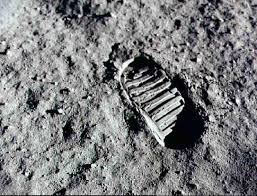Pink Floyd's Darkside of the Moon album had nothing to do with the moon; however, still great music. We have all heard of the phrase 'dark side of the moon', but is there really a dark side?
Did you know... observers from earth always see the same side of the moon. How can this be? According to statistical data, the rate of rotation is equal to the rate of revolution around earth. With these two values similar, the same side of the moon always faces earth. Think about this: if the rate of rotation was equal to the rate of revolution around the sun for earth, then one side of Earth will be extremely hot and the other side will be extremely cold.
The dark side of the moon is a fictitious phrase. Think about this: when the moon is at the new moon phase, the observer from earth sees a "dark moon" the other side of the moon is all lit (as though it is a full moon). In reality, we should call that portion of the moon we do not see from earth as simply as "the other side".
Friday, October 23, 2009
Lunar Morphology

Many people think that our moon is made out of cheese. From a scientific standpoint, that is definitely false. There are many striking things we can see from earth when looking at the moon. Look at this picture, what can you see?
- Large dark spots;
- Mainly white colored
The large dark spots are called Maria. Early scientists thought the spots were lunar seas and maria is Latin for sea. These spots are iron-rich in composition as compared to the lighter areas of the moon (silicate-rich).
Another striking thing is lunar temperature. During the day when insolation from the sun is at the greatest, the temperature of the lit side of the moon can get as high as 240°C and on the other side of the moon can get as low as -240°C. The extremely low temperature is due to the lack of the sun's radiation.
Giant Impact

Since scientists were not around 4.4 to 4.5 billion years ago, scientists must think of ways as to how the moon was made and how earth may have captured it in it's gravitational field.
The successful Apollo moon landing narrowed several theories down to a single theory. Scientists analyzed moon dust and rock samples that were retrieved from the Apollo 11 mission. The samples were high in silicates, which is very similar to Earth's mantle composition.
The Giant Impact between Earth and another planet-sized body seems to be a logical solution. I read this journal article from the Nature weekly science journals that corresponds to this data. Apparently, this planet-like celestial body collided with Earth in its molten state. As this planetesimal departed from the collision, it collected Earth's molten material, which cooled to form a silicate rich crust.
Thursday, October 1, 2009
Is it spring again?

I cannot tell you that walking past the Northport Harbor the horrendous odor you can encounter. Why does this occur? Well we experience two high and low tides per day. During low tide, sea level is at its lowest point, and during high tide, sea level is at its highest point. The differences between tides are best seen inside a harbor or along the shoreline where a significant summer or winter berm is present.
When low tide is near, villages and towns release sewage effluent into the nearby harbor or inlet. The horrendous odor that I smelled came from storm water effluent, or decaying organic matter.
Why do we experience tides? Due to the gravitational forces between earth, sun, and moon. Since the moon is a celestial body orbiting around earth, the moon and earth have a gravitational attraction. The pull of the moon slightly displaces the earth. We experience high tides where the earth is facing the moon and directly opposite of the same. The remaining two sides of the earth experience low tide (see picture).
When the sun is mixed into the equation, it enhances earth's high and low tides. When the sun, earth, and moon are aligned in a straight line, the high tides are even higher! These tides are called spring tides. When the three celestial bodies are not aligned, the tides are lower. When the moon positioned perpendicular to the sun in Earth's orbit, the tides are even lower than normal! These tides are called neap tides. This animation on tides really depict spring and neap tides. The above image demonstrates the lunar phases along with spring and neap tides.
Use this hyperlink to learn more on tides from the NOAA website:
National Oceanic and Atmospheric Administration: Tides and Currents
Subscribe to:
Posts (Atom)





